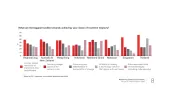
The reduced avalability of liquidity
One of the most obvious consequences of the credit crisis has been the reduced availability of external liquidity. Mario Tombazzi, Regional Head of Liquidity Product Management for Asia at HSBC, examines the lessons that have been learnt and the most effective responses.
The recent and sudden contraction in available liquidity has prompted many treasuries to seriously reconsider their existing liquidity strategies. While much of this focus has inevitably been on fulfilling immediate needs, the situation also represents an opportunity to put in place structures that will deliver long term benefits in terms of return, flexibility and risk management.
Treasurers who resist the temptations of a quick fix will be taking a major step towards ensuring the long term stability and profitability of their corporations.
Liquidity risk is real – deal with it
Events of the past eighteen months have brought a widespread realisation that liquidity risk is just as real in terms of its impact on the corporation as credit or foreign exchange risk. In the past, companies with respectable credit ratings were able to tap seemingly limitless and inexpensive liquidity via issuance of commercial paper, notes or bonds – or turn to banks to take advantage of uncommitted facilities. This relaxed era is now most definitely over. In the current liquidity-constrained environment, it is vital to have a proper frame- work which can be used to mitigate liquidity risk; and in particular to make optimal use of internal liquidity, which has shot up in value.
The basic starting point is complete visibility at the treasury level of all corporate cash, so that the cash position, funding requirements and investment transactions can be tracked in real (or near-real) time. Corporate cash must also reside within a mechanism that allows any idle balances to be used quickly and efficiently.
In addition, the associated investment policy has to be robust, with all the appropriate risk parameters, checks and controls in place.
Finally, accurate forecasting of corporate cash flows and the ability to model appropriate stress scenarios to test the resiliency of liquidity reserves to external shocks are essential.
If the forecasting process is hampered by poor practices or discipline, then the treasury will always be struggling with unpleasant surprises that only add to the pressure on liquidity management.
A consideration that ironically may deter some companies from acting on this is that their liquidity need is immediate. A complete robust liquidity management framework is perceived as a major project with a multi-month (if not multi-year) timeline.
The concern is that by the time the investment is made and the project completed, it will be too late.
Not so. Given a banking partner with sufficient implementation expertise and adequate dedicated resources on the client side, a liquidity structure can be established in just a few weeks. An overlay structure is obviously faster to implement than a complete liquidity and cash management service.
Nevertheless, a bank with a solid local, regional and global track record on execution will still be able to incorporate the transactional banking element swiftly. A fully integrated end-to-end solution of this nature will deliver precisely the sort of future-proof banking service that will always put the company in full control of its liquidity position.
Credit - a limited resource
Given that credit markets have moved rapidly from monsoon to drought, another important lesson has been the need to have a diversified portfolio of credit facilities, ranging across both lending institutions and facility types (e.g. committed and uncommitted lines).
This will then ensure that the appropriate tool or contingency measure is always available to cover the liquidity risk. Credit may inevitably be more expensive than in the past, but it need not be unavailable; though fully resilient contingency measures currently incur a higher cost.
Nevertheless, this requires considerable skill and effort with bank relationship management. Previously easy credit conditions meant that lenders were taking a relatively relaxed view on borrower ratings, in the knowledge that the risk could be laid off through credit swaps, portfolio diversification or other financial repackaging. This is clearly much more difficult to accomplish in the current flight to caution.
There is therefore a need to maintain a diversified panel of credit relationship banks, but the quality of relationship with those banks is critical. Depth of relationship and mutual trust are vital to ensuring support when it is most needed and many corporations are realising that a greater degree of transparency is needed in order to achieve this.
Liquidity – what’s it worth?
For those corporations with surplus liquidity to park, one of the most striking changes has been that the value of surplus cash (and hence the return available on it) varies widely from institution to institution; there is no ‘standard’ rate.
The deposit taker’s need for liquidity is the primary pricing driver. (Although this equation has been complicated by central banks injecting liquidity into the markets.) Those with depleted balance sheets or funding gaps will be prepared to bid up deposit rates in order to get the cash they need.
Unfortunately these entities by definition also represent a significant credit/liquidity risk that prudent treasuries will wish to avoid. By contrast deposit takers with strong balance sheets and matched funding of their asset books have a rather different challenge – how to utilise deposits. It is clearly inappropriate to relax lending standards simply to dispose of surplus liquidity. Unfortunately, the declining number of third parties of acceptable credit quality means that good quality deposit taking institutions can responsibly obtain only relatively low returns on deposits, which impacts the rates they can offer clients.
Unfortunately this important distinction is sometimes missed. Corporations that still rely on conventional credit ratings assume that all banks with the same or similar rating should logically offer the same deposit rates.
Nothing could be further from the truth. More sophisticated treasuries have realised that conventional credit ratings are an extremely blunt instrument for measuring credit risk under abnormal market conditions.
Real and relative benefits
Given the current market conditions and the resources required to implement a liquidity solution, corporations are understandably keen to gain a clear picture of the possible benefits before committing resources. Ultimately this is a function of the complexity of the structure considered, which can be represented by the following three essential elements and their various possible combinations: location, currency and entity.
As one moves from single to multi factor status for each of these elements, the solution complexity increases. For example, a single currency liquidity structure for a single entity in one location is relatively undemanding. As one adds multiple factors (such as a multi currency structure across multiple entities in a single location) more effort is involved.
Therefore any increase in complexity must be carefully weighed against the associated increase in cost and incremental benefits. Whichever combination is used has to be considered in two contexts; unregulated and regulated markets.
In the case of unregulated markets the treasurer is looking for a solution that effectively consolidates positions, typically across countries, entities and currencies. This provides three primary benefits:
• Offsetting – the compensation of credit against debit balances. In a single currency the offset is typically full; where multiple currencies are involved, the associated balance sheet and exchange rate risk implications mean the offset will still be high, but not total.
• Stable core balance – individual cash balances may be volatile, but aggregating them produces a larger, more stable core balance with lower volatility. The more predictable behaviour of this core balance makes it easier to manage in terms of planning its utilisation, while also reducing the need to continually adjust forecasts.
• Utilisation – most physical and notional pooling solutions allow the treasury to easily access the core balance and deploy it to best effect. These solutions are now also expanding so that this is also possible on a multicurrency basis. Multicurrency interest “optimisation” (as it is referred to at HSBC) has become more transparent in terms of the pricing mechanism and documentation required for establishment and maintenance, and is therefore attracting considerable interest from sophisticated multinational corporate treasurers.
In the case of regulated markets, the above benefits are clearly unavailable because the cash positions cannot be efficiently mobilised. However, an alternative solution is interest “enhancement”, where the cash holdings all remain in their original domicile but attract enhanced interest conditions in recognition of their combined value. Again, this solution is both consistent across the region and transparent, in that the structure is dynamic and the pricing is periodically adjusted based upon preset parameters that reflect the overall client relationship.
Current and future benefits
In the present environment, the ability of unregulated market solutions to offset positions and derive a stable cash core is a critical advantage. Such a source of stable internal funds has an intrinsic value to each company which varies according to its internal working capital dynamics as well as external financial market conditions.
There are times when it is strategically prudent to build up cash reserves and other situations where the priority is on reduction of external indebtedness; vital when one considers the current gulf between the cost of internal and external liquidity sources. In the case of regulated markets the principal driver in the current conditions is preferential relation- ship-based pricing. Even though the cash cannot be moved, there is still a need to make the best possible use of it. A final important point to consider is the longevity of these benefits.
When comparing offerings from various providers, the corporate treasury needs to be utterly certain that the provider can guarantee the material benefits will still apply when market conditions improve.
Restructuring the bank relationship model
Many treasuries started considering cash and liquidity management projects in the good times, but these were often postponed due to other business priorities; a decision now regretted. Procrastination inevitably results in a reactive rather than proactive response when conditions subsequently deteriorate.
Nevertheless, if approached in the right manner, much is still possible. The most critical point is that any quick fix undertaken now needs to be a considered first step in a long term roadmap; not just a quick fix in isolation that will have to be subsequently discarded and replaced. For example, an overlay structure is comparatively simple to implement, but doing so without considering how it will evolve into a consolidated structure incorporating other transactional banking services is short sighted and ultimately inefficient, if not costly.
If the overlay is provided by a bank incapable of the transactional banking element, then this will have to be provided by another bank and significant synergies will be lost. Transactional banking providers sometimes waive or reduce fees on the basis of interest margins realised on frictional and residual deposit balances. Therefore treasuries also need to consider the long term viability of services being offered under the envisaged local and regional banking model, taking into account both existing and possible future market conditions. Is there room for relationship expansion with all banking counterparties, and are they able to maintain the same level of service quality and concessionary transaction pricing if there are material shifts in the cash holdings and transaction processing patterns? Today the pricing of the two services are strongly correlated, and if the relationship ceases, pricing realignment will be necessary, which will have an impact on the overall benefit; a consideration that is currently often overlooked.
Conclusion
It is tempting to argue that now is not the right time to embark on a cash and liquidity management implementation. Unfortunately, procrastination is not a strategy at the best of times - and definitely not in the current times. Given the right provider, swiftly establishing an improved banking model now is perfectly possible; delay is not the inevitable stratagem.
Even though there is currently a huge temptation to think short term and adopt a superficial quick fix overlay in isolation, this can condemn the organisation to repeat expensive history. Any well-planned structure supported by a provider who can offer a homogenous solution for regulated and unregulated markets will deliver long term returns, irrespective of future market conditions. However, the critical point is that such a solution must be fully integrated end-to-end. Piecemeal products that cannot incorporate the transaction banking element are a recipe for sub-standard performance and future re-engineering costs.



















 Advertise
Advertise








